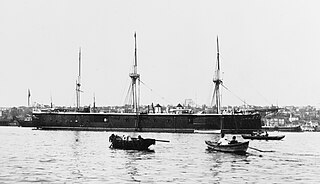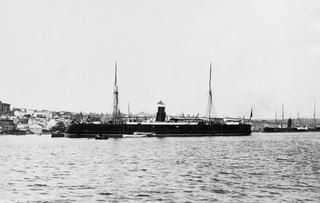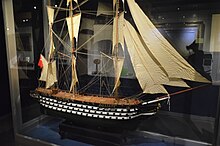
Mesudiye was a central-battery ironclad of the Ottoman Navy, one of the largest ships of that type ever built. She was built at the Thames Iron Works in Britain between 1871 and 1875. Mesudiye had one sister ship, though she was purchased by the Royal Navy and commissioned as HMS Superb. Her primary armament consisted of twelve 10-inch (250 mm) guns in a central armored battery.

Asar-i Tevfik was an ironclad warship of the Ottoman Navy built in the 1860s, the only member of her class. She was built as part of a major expansion program for the Ottoman fleet in the 1860s following the Crimean War. Asar-i Tevfik was a 4,600-metric-ton barbette ship armed with a main battery of eight 220-millimeter (8.7 in) guns in a central battery. In 1903–1906, the ship was extensively rebuilt in Germany and a new battery of 150 mm (5.9 in) and 120 mm (4.7 in) quick-firing guns replaced the older weapons.

The Feth-i Bülend class was a class of two ironclad warships built for the Ottoman Navy in the 1860s and 1870s. The lead ship, Feth-i Bülend, was built in Britain, and served as the basis for the second, Mukaddeme-i Hayir, which was built in the Ottoman Imperial Arsenal. The design for the ships was based on the earlier Avnillah class, which were also built in Britain. Central battery ships, Feth-i Bülend and Mukaddeme-i Hayir were armed with a battery of four 222 mm (8.7 in) Armstrong guns in a casemate.

Muin-i Zafer was the second of two Avnillah-class casemate ships built for the Ottoman Navy in the late 1860s. The ship was laid down in 1868, launched in 1869, and she was commissioned into the fleet the following year. A central battery ship, she was armed with a battery of four 228 mm (9 in) guns in a central casemate, and was capable of a top speed of 12 knots.

Lütf-ü Celil was an ironclad warship of the Ottoman Navy, the lead ship of the Lütf-ü Celil class. Originally ordered by the Khedivate of Egypt, an autonomous vassal state of the Ottoman Empire, the central Ottoman government forced Egypt to surrender Lütf-ü Celil while she was still under construction at the French Forges et Chantiers de la Gironde shipyard. Lütf-ü Celil saw action during the first weeks of the Russo-Turkish War in 1877, where she operated on the Danube to try to prevent Russian forces from crossing the river. While on patrol on 11 May, she engaged a Russian artillery battery that scored a hit on the ship's boiler room, causing an explosion that destroyed the ship and killed most of her crew.

The Lütf-ü Celil class was a pair of ironclad warships built for the Ottoman Navy by a French shipyard in the late 1860s. Originally ordered by the Eyalet of Egypt but confiscated by the Ottoman Empire while under construction, the class comprised the vessels Lütf-ü Celil and Hifz-ur Rahman. The ships were sea-going monitors that mounted their main battery of two 225 mm (8.9 in) Armstrong guns and two 178 mm (7 in) Armstrong guns in two revolving gun turrets.

Asar-i Şevket was a central battery ship built for the Ottoman Navy in the 1860s. Originally ordered by the Eyalet of Egypt but confiscated by the Ottoman Empire while under construction, the vessel was initially named Kahira. The ship was laid down at the French Forges et Chantiers de la Gironde shipyard in 1867, was launched in 1868, and was commissioned into the Ottoman fleet in March 1870. Asar-i Şevket was armed with a battery of four 178 mm (7 in) Armstrong guns in a central casemate and one 229 mm (9 in) Armstrong gun in a revolving barbette.

Necm-i Şevket was the second of two Asar-i Şevket-class central battery ships built for the Ottoman Navy in the 1860s. Originally ordered by the Khedivate of Egypt but confiscated by the Ottoman Empire while under construction, the vessel was initially named Muzaffer. The ship was laid down at the French Forges et Chantiers de la Gironde shipyard in 1867, was launched in 1868, and was commissioned into the Ottoman fleet in March 1870. Asar-i Şevket was armed with a battery of four 178 mm (7 in) Armstrong guns in a central casemate and one 229 mm (9 in) Armstrong gun in a revolving barbette.

The Asar-i Şevket class of ironclad warships consisted of two vessels, Asar-i Şevket and Necm-i Şevket, built for the Ottoman Navy in the 1860s. The ships were constructed in France and were based on the design of the earlier ironclad Asar-i Tevfik. The two vessels, built as central battery ships, carried an armament of four 178 mm (7 in) Armstrong guns in a central casemate and one 229 mm (9 in) Armstrong gun in a revolving barbette atop the casemate.

Iclaliye ("Glorious") was a unique ironclad warship built for the Ottoman Navy in the late 1860s and early 1870s. She was ordered from the Austro-Hungarian shipyard Stabilimento Tecnico Triestino, was laid down in May 1868, and was completed in February 1871. The design for Iclaliye was based on the earlier Asar-i Şevket-class ironclads built in France, though she carried a slightly more powerful armament consisting of two 228 mm (9 in) Armstrong guns and three 178 mm (7 in) Armstrong guns. During the Russo-Turkish War she supported Ottoman forces fighting in the Caucasus. She spent most of the rest her career out of service, as the Ottoman Navy was allowed to languish. In 1912, the Navy activated the ancient Iclaliye to help provide artillery support to the forces defending Constantinople. She served in subsidiary roles, including as a training ship and a barracks ship, until 1928 when she was decommissioned and broken up.

Osmaniye, named for Sultan Osman I, was the lead ship of the Osmaniye class of ironclad warships built for the Ottoman Navy in the 1860s by Robert Napier and Sons of the United Kingdom. A broadside ironclad, Osmaniye carried a battery of fourteen 203 mm (8 in) RML Armstrong guns and ten 36-pounder Armstrongs in a traditional broadside arrangement, with a single 229 mm (9 in) RML as a chase gun. Among the more powerful of Ottoman ironclads, the Navy decided to keep the ship out of the action during the Russo-Turkish War of 1877–1878 to preserve the vessel. She spent the 1880s out of service, though she was heavily rebuilt in the early 1890s and converted into a more modern barbette ship. She was nevertheless in poor condition by the time of the Greco-Turkish War in 1897, as a result saw no action, and was disarmed after the war. She remained in commission until 1909 but saw no further service, and was broken up in 1923.

Mahmudiye, named for Sultan Mahmud II, was the fourth of four Osmaniye-class ironclad warships built for the Ottoman Navy in the 1860s. She was the only member of her class built at the Thames Iron Works, with work lasting from her keel laying in 1863 and her launching in 1864. A broadside ironclad, Mahmudiye carried a battery of fourteen 203 mm (8 in) RML Armstrong guns and ten 36-pounder Armstrongs in a traditional broadside arrangement, with a single 229 mm (9 in) RML as a chase gun. Among the more powerful of Ottoman ironclads, the Navy decided to keep the ship safely in the Mediterranean Sea during the Russo-Turkish War of 1877–1878 to preserve the vessel. She spent the 1880s out of service, though she was heavily rebuilt in the early 1890s and converted into a more modern barbette ship. She was nevertheless in poor condition by the time of the Greco-Turkish War in 1897, as a result saw no action, and was disarmed after the war. She saw no further active service, being used briefly as a barracks ship from 1909 to 1913, when she was sold to ship breakers and dismantled.
The Osmaniye class was a group of four ironclad warships built for the Ottoman Navy in the 1860s. The class comprised Osmaniye, the lead ship, Aziziye, Orhaniye, and Mahmudiye. They were the first vessels of the type to be built for the Ottoman Empire; all four were built in Great Britain, the first three by Robert Napier and Sons and the fourth by Thames Iron Works. The ships were broadside ironclads, carrying a battery of fourteen 203 mm (8 in) Armstrong guns and ten 36-pounder Armstrong guns in a bank of guns on each broadside.

Feyzâ-i Bahrî was one of four wooden-hulled Mecidiye-class paddle frigates built for the Ottoman Navy in the 1840s; they were the first Ottoman-built warships powered by steam. She served with the fleet until 1867, including during the Crimean War, where she saw a minor battle with a Russian frigate in the Black Sea. Feyzâ-i Bahrî ferried soldiers to Crete during the Cretan Revolt in 1866 and was converted into a dedicated transport vessel the following year. She served in that capacity until 1878 when she was decommissioned, being broken up in 1880.

Mecidiye was the lead ship of four wooden-hulled Mecidiye-class paddle frigates built for the Ottoman Navy in the 1840s; they were the first Ottoman-built warships powered by steam. She was modified during construction to be used as a yacht by the sultan of the Ottoman Empire. During the Crimean War, she took part in a minor, inconclusive battle with a Russian frigate but otherwise saw no further action. She saw limited service for the remainder of her career, including during the Russo-Turkish War of 1877–1878. She ended her career as a coal storage hulk and was broken up in 1903.

Taif was one of four wooden-hulled Mecidiye-class paddle frigates built for the Ottoman Navy in the 1840s; they were the first Ottoman-built warships powered by steam. She served with the fleet until 1867, including during the Crimean War, where she saw a minor battle with a Russian frigate in the Black Sea. She was present at the Battle of Sinop, but her steam engine allowed her to escape before the Russian fleet destroyed the Ottoman squadron in the port. The ship remained in service until 1867, seeing little activity during this period, and was ultimately broken up in 1868.
Mubir-i Sürur was a steam frigate of the Ottoman Navy built in the 1840s. Originally ordered by the Eyalet of Egypt as Sarkiye, upon completion she was presented as a gift to Sultan Abdulmejid I and was renamed on entering service in the Ottoman fleet in 1850. She had a relatively uneventful career, avoiding any active service during the Crimean War in 1853–1855. She was used to patrol for Greek blockade runners during the Cretan Revolt in 1866, and was reduced to a training ship in 1873. She returned to active service in 1877 following the outbreak of the Russo-Turkish War, during which she was used to ferry Ottoman troops around the Black Sea. The ship remained in service until 1885, when she was reduced to a storage hulk; she was ultimately broken up in 1904.

Sultaniye was a royal yacht of the Ottoman Empire. She was originally built for the Egyptian fleet in the early 1850s and was initially named Feyz-i Cihat before being given to the Ottoman sultan as a gift in 1862. She was renamed at that time and served as the sultan's yacht for the next fifty years before being placed in reserve in 1905. She was eventually scuttled off Izmir on 20 April 1912 during the Italo-Turkish War.
Samsun was one of the four Durandal-class destroyers purchased by the Ottoman Empire from France in 1907. The ship served in the Ottoman Navy during the Italo-Turkish War, the Balkan Wars and World War I.














